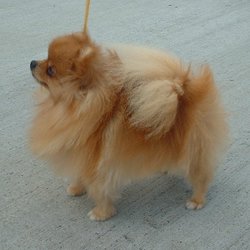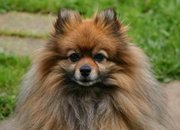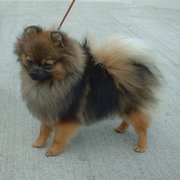Pomeranian
Dogs
Pomeranian
| Pomeranian |

A red Pomeranian
|
| Alternative names |
Deutscher Zwergspitz
Toy German Spitz |
| Country of origin |
|
Poland
and
Germany |
| Common nicknames |
| Pom |
| Classification and breed standards |
|
FCI: |
Group 5 Section 4 #97 |
|
|
AKC: |
Toy |
|
|
ANKC: |
Group 1 (Toys) |
|
|
CKC: |
Group 5 - Toys |
|
|
KC (UK): |
Toy |
|
|
NZKC: |
Toy |
|
|
UKC: |
Companion Breeds |
|
| Not recognized by any major kennel club |
| This breed of dog is
extinct |
| Notes |
| |
The Pomeranian is a
breed of
dog in the
spitz family,
named for the
Pomerania region of
Poland and
East
Germany, and classed as a
toy dog breed
because of its small size.
Appearance
 Sable Pom's face
Sable Pom's face
At an average of 3 to 7 lb (1.4 to 3.2 kg) according to
AKC standards, the Pomeranian (Pom) is the most diminutive of the northern
breeds.
The head of the Pomeranian is wedge-shaped, making it somewhat
foxy in appearance.
The ears are large and pointed. Its
tail is
characterstic of the breed and should be turned over the back and carried flat,
set high.
The Pom's coat is its glory, two coats, an
undercoat
and a top
coat; the first is soft, thick, and fluffy; the latter is a long, perfectly
straight and glistening coat covering the whole body. The undercoat is shed
during warm weather conditions.
The AKC recognizes thirteen colors or color combinations: black, black & tan,
blue, blue & tan, chocolate, chocolate & tan, cream, cream sable, orange, orange
sable, red, red sable, and sable. The AKC also recognizes five "alternative"
colors: Beaver, brindle, chocolate sable, white, and wolf sable.
At least one breed standard calls for a cobby, balanced dog. A cobby dog is a
long or shorter than he is tall; try to picture him as a circle in a square. A
balanced Pomeranian fits together logically and in proportion. For instance, a
small, delicately boned Pom with a large head looks unbalanced because his head
type doesn't match his body type. A balanced Pom displays legs in proportion to
his body: neither so short as to make him appear dumpy nor so long as to make
him look like he is walking on stilts.
The standard also calls for an expression that imparts great intelligence,
showing that the Pom has an alert character and that he behaves accordingly. The
pom's alertness makes it a superb watchdog.
Temperament
The Pom is an active dog who is intelligent, courageous, and a loyal
companion. The Pomeranian may not interact well with small children, and due to
its small size can suffer abuse from children.
Pomeranians have proven themselves to be excellent watchdogs by announcing
intruders with loud, sharp barks.
The Pomeranian easily adapts to life in the city, and is an excellent dog for
country living with its strong hunting instincts from its wild ancestors.
History
The Pomeranian originated from the
sled dogs
of Iceland
and Lapland,
which were eventually brought into
Europe. The
Germans improved the coat and bred the dogs down for city living, but they were
still 20 pounds or more when they reached
England.
 An orange-sable Pomeranian
An orange-sable Pomeranian
English breeders, through trial and error and
Mendelian theories, are credited for reducing the dog's size and developing
the many colors. The Pomeranian of today is small due to selective breeding, but
the breed still retains the hardy disposition and thick coat typical of dogs in
cold climates.
The Pomeranian became internationally popular when
Queen Victoria returned from vacation in
Florence, Italy
with a Pomeranian named Marco.
The closest relatives of the Pomeranian are the
Norwegian Elkhound, the
Samoyed, the
Schipperke,
and the whole Spitz group.
Health
Pomeranians are generally a healthy, hardy, and long-lived breed—often, Poms
live 15 or 16 years.
The teeth of the Pomeranian can be the cause of serious health concerns for
the breed. The teeth must be meticulously cared for through frequent cleaning to
prevent the teeth from falling out at a rather early age. Problems with the
teeth can cause heart problems which may lead to an early death.
Pomeranians are known to have a higher likelihood of suffering from
seizures
either from
idiopathic
epilepsy or
hypoglycemia
Another common ailment is a dislocated
patella.
Miscellaneous
Famous Pomeranians
-
Fran Drescher's Pomeranians,
Esther Drescher and
Chester Drescher
-
Sharon Osbourne's Pomeranian, Minnie
-
Nicole Richie's Pomeranian, Foxxy Cleopatra
References
-
[[|Spirer, Louise Ziegler; & Spirer,
Herbert F., ]], () ( 1965). "" [
This is the Pomeranian], , , , : TFH
Publications. ISBN
0-87666-354-4..
-
[[|Liebers, Arthur; & Sheppard, Georgia
M., ]], () ( 1959). "" [
How to Raise and Train the Pomeranian], , , , : TFH
Publications. ISBN
0-87666-352-8..
External links
Home | Up | Papillon | Parson Russell Terrier | Patterdale Terrier | Pekeapoo | Pekingese | Pembroke Welsh Corgi | Perro de Presa Canario | Peruvian Hairless Dog | Petit Basset Griffon Vendeen | Phalčne | Pharaoh Hound | Plott Hound | Polish Lowland Sheepdog | Polish Scenthound | Pomeranian | Pont-Audemer Spaniel | Poodle | Poodle Hybrid | Portuguese Podengo | Portuguese Water Dog | Pudelpointer | Pug | Puli | Pumi | Pyrenean Mountain Dog | Pyrenean Shepherd
Dogs, made by MultiMedia | Free content and software
This guide is licensed under the GNU
Free Documentation License. It uses material from the Wikipedia.
|




